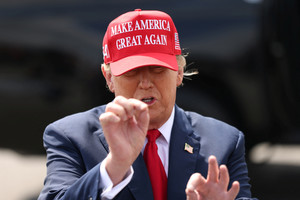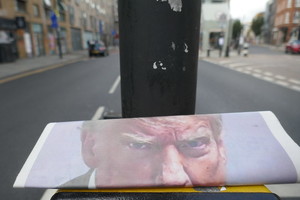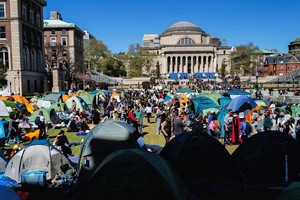Can Open Primaries Reduce Polarization?

This piece was originally published on Divided We Fall, which AllSides rates as mixed. It was written by Jeremy Gruber, Dan Butler, Sarah Anderson, and Laurel Harbridge- Young.
By Jeremy Gruber – Senior Vice President at Open Primaries
"That this nation, under God, shall have a new birth of freedom, and that government of the people, by the people, for the people, shall not perish from the earth.”
Our democracy is increasingly struggling to realize this noble aspiration captured in Abraham Lincoln’s Gettysburg Address. There are several root causes, but one is uniquely American among world democracies. Our systems of elections are a partisan construct where incentives to seek advantage can often conflict with fundamental democratic principles.
Rules for how the two major parties—Democratic and Republican—control the participation and administration of our country’s elections are ingrained in each state’s electoral code. Secretaries of State are as likely to be leaders in partisan movements as they are independent election watchdogs. Many states require election workers to be members of one of the two major parties and outsource their selection to party leaders. If you are not a registered Republican or Democrat, you can’t serve on many state or local boards of elections nor serve as an election judge.
The primary election system is a particularly egregious example of the consequences of allowing private organizations to control the electoral machinery. Primary elections are publicly funded and every state spends tens of millions of taxpayer dollars to run them every election year. They are held in public locations, staffed by public-paid workers, run on public-owned machines, and administered by publicly elected officials. And yet, by law, these private entities write the rules that determine who can and cannot participate.
Forty-six states use party-controlled primary election systems, with many of them placing restrictions on the participation of registered independents if not outright entirely barring them. For example, Arizona allows independent voters to vote in legislative primaries but not presidential primaries. Oklahoma and South Dakota allow independents to vote in Democratic primaries but not Republican primaries. The rules are written to privilege the parties at the expense of the voters.
This has always been an injustice and a stain on democratic rule. Every voter should have equal access to every publicly funded election. It’s also increasingly becoming a key driver of political polarization and government dysfunction as well.
How did this happen? Primary elections were a key reform of the Progressive era of the early twentieth century. They represented a significant advancement: the invitation of the voters into the smoke-filled rooms where party nominations had previously been decided. This worked for decades because almost every registered voter in the U.S. was a Republican or Democrat. In 1961, over 80% of Americans were members of either the Democratic or Republican parties. That is nowhere near the case, today.
We are now in the middle of a political realignment with very dramatic consequences for how our democracy works. One or both major parties are contracting in almost every state. The largest and fastest growing group of voters are now registered, independent voters. They are already the largest or second largest group of voters in half the states in the country. Within a few years, they will dominate every state. 50% of millennials and Gen-Z voters, the largest block of voters in the country by age, are registering as independents. That’s having a profound effect on a political system that wasn’t designed for them.
This sea change in how voters are affiliating politically is interacting with another major historical trend: the decades-long drop in general election competition. Competition for Congressional seats is at the lowest level in several decades. Out of 435 seats in the House of Representatives, only 40 are considered competitive. It’s even worse in state legislatures. In 2020, 35% of general election races saw candidates running unopposed. Unopposed! It’s no wonder the U.S. has such low voter participation; our elections are becoming less and less meaningful.
This means that primary elections are increasingly the elections that matter. And with large segments of the electorate shut out in closed partisan primaries, smaller and smaller groups of increasingly partisan voters are calling all the shots. People running for office must swear allegiance to the most partisan principles of their party, as a result. That’s not only producing more polarizing candidates but also limiting the pool of voters these candidates are accountable to in order to get elected and stay in office.
Most politicians in America today worry about one thing above all others: being “primaried.” As former Congressman Steve Israel told the NY Times. “When I was a member of Congress, most members woke up concerned about a general election… now they wake up worried about a primary opponent.” The whole system limits politicians, confining them and restraining their ability to work for the common good.
What’s the solution? It begins with letting every voter vote. Public elections that shut out tens of millions of voters are, on their face, an affront to democracy and a self-evident recipe for dysfunctional government.
Four states — California, Washington, Nebraska (for state legislative race), and Alaska (starting this year) — now conduct nonpartisan public primaries. It is not a new concept; 85% of cities in the United States, including 23 of the 30 largest cities, use nonpartisan elections to elect municipal officers.
It’s a simple solution with profound implications. All candidates, regardless of party, appear on the same ballot. All voters participate in this public, open primary and choose from among all the candidates — just like in a general election. Candidates are thereby focused on assembling stable cross-partisan political coalitions from day one, not simply pandering to the most fervent partisans in their own party in order to get elected. The top two or top four candidates advance to the November election, regardless of party. Primary elections and general elections become more competitive, and voter participation goes up as a result.
If we had open primaries in all 50 states, voters would have more power and our political representatives would be incentivized to work much differently. The ability of partisan leaders and political bosses to demand fealty to narrow agendas would be significantly curtailed. Elected leaders would be freer to vote their conscience. We would see more cooperation, more productive governing, and less partisanship because that’s how representatives who are accountable to their entire constituency tend to act. The people, not the parties, would be in the driver’s seat.
Conducting open primaries does not mean the end of political parties. They still play a critical role in bringing together like-minded people, promoting issues, and recruiting and training candidates. But parties function best when they are participants in the process, not the dictators. The current system, which cedes too much power and control to the political parties, incentivizes politicians to prioritize the interests of the few over the common good. Open systems foster collaboration and bridge building in the service of finding real solutions. Closed systems foster zero-sum game machinations and partisan manipulation.
We stand at a critical juncture in the history of our democracy. We cannot allow partisan constructs, like our closed-party primary system, to disempower voters and handcuff elected representatives. It’s time to open up the primaries and let all voters vote.
By Dan Butler of Washington University in St. Louis, in collaboration with Sarah Anderson of the University of California Santa Barbara and Laurel Harbridge-Yong of Northwestern University
It comes as no surprise that politicians are most responsive to the segment of voters who elected them. What may be more surprising, however, is that very few elected officials serve in districts that have competitive general elections. Instead, primary elections are now much more likely to determine who ultimately serves in office. Partisan control of the redistricting process, combined with a rise in the sorting of voters into increasingly ideological parties, has had the effect of making general elections significantly less competitive.
In surveys of state legislators, my colleagues and I found that when voting on legislation, incumbents are most worried about retribution from their primary voters for taking compromise positions. Anticipating the needs of primary voters, incumbents act to make sure that these voters have little reason to boot them from office. As a result, they’re responsive to a smaller and more partisan segment of their constituents.
For this reason, proposals to reform closed party primaries in the hopes of increasing voter turnout are appealing to many. Electoral reforms, such as the top-two primary, seek to make moderate candidates more viable. Under the top-two system, all candidates are listed on the same primary ballot. The top-two vote getters, regardless of party, advance to the general election. The hope in this proposal is that voters from the minority party in the district will exert greater influence in elections. If savvy voters realize that their preferred candidate from their own party can’t win, they might vote for a moderate candidate from the opposing party. This could lead to competitive general election races between two candidates from the same party, with the more moderate candidate winning.
The effectiveness of these reforms, however, depends on if they succeed in two areas: 1) attracting more moderate primary voters, and 2) encouraging voters to act strategically and cross party lines in support of moderate candidates. Unfortunately, evidence indicates that neither of these have occurred in early adopting states of the top-two primary.
Data has shown that simply making it possible for more voters to participate does not necessarily lead them to do so. As Eric McGhee and coauthors show, “The openness of a primary election has little, if any, effect on the extremism of the politicians it produces.”
Relatedly, political scientists have found that the voters who participate in closed primaries are not all that different from open primaries. Furthermore, evidence suggests that voters are unlikely to vote for a moderate member of the opposing party, even if their preferred candidate is unlikely to win. As a result, a top-two primary system alone is unlikely to yield more moderate candidates.
A more desirable alternative to the top-two primary might indeed be the top-four primary, which takes into account voter patterns. In the top-four primary system, which Alaska recently voted to implement, all candidates are again listed on the same primary election ballot. This time, however, the top four vote-getting candidates move on to the general election. With four general election candidates, a more moderate candidate can emerge from the primary election, even if that moderate candidate would not have a plurality of votes in a traditional primary election.
As a result, in the general election (where independents are more likely to participate), the more moderate candidate has the chance to improve their vote share and win. Under this system, independents need not show up to vote in primary elections in order for more moderate candidates to succeed. Instead, their voting power can be felt in the general election, where they make up a greater portion of the electorate.
One of the most effective ways to combat hyperpartisanship is to increase moderate voters’ participation in primary elections. But as we have seen, achieving that goal is hard. So how can we get moderates to vote? We can either change the rules to make them vote or find ways to encourage them to vote.
In terms of rule changes, a promising option would be to enact some form of compulsory voting (like that used in Australia and Belgium) in a top-two or top-four primary system. This, however, remains unlikely in the near future. Incumbents have little incentive to pass reforms, as the status-quo has proven beneficial for them. Their voters, by definition, already show up to vote in large enough numbers to elect them. Because adding new compulsory voters is risky for incumbents, a ballot initiative (i.e. not requiring support of incumbent elected officials) might be the only way forward in this regard.
Outside of electoral reform, citizens can mobilize to increase moderate voters’ participation in primaries through activism and other civic-minded initiatives. Several tactics include assisting voters to the polls, using social media to raise awareness, and volunteering for moderate candidates’ campaigns, among others.
Too often moderate and independent voters believe that voting in the general election is enough and then lament the polarization of elected officials. Politicians are most worried about their primaries and they are going to focus on appealing to voters in that electorate. If voters want to make a difference, they must participate in the elections that matter: the primaries.
By Jeremy Gruber – Senior Vice President at Open Primaries
Political scientists often make the mistake of thinking that democracy is primarily about outcomes because outcomes are more easily studied. It’s not. Democracy is primarily about values. Almost 250 years ago, our founding fathers launched a bold experiment in self-government with no way of proving the outcome would be any better. Just read any of the founding documents of our republic and you’ll find nothing but a discussion of values. Values like fairness, equality, and freedom. Our founders knew that when an election system reflects the values of voters, they trust it regardless of the outcome.
That’s why ever since California enacted nonpartisan primaries ten years ago, they have consistently enjoyed over 60% voter support. It’s also why approval of the state legislature, which was dismal for years, has consistently been three times higher than what it was when politicians were elected in a partisan system.
Moreover, moderation, if such a thing even exists, is a false metric. The idea that elected leaders should take political positions in the middle on every issue is just another form of extremism. Voters don’t want moderation; they want innovation and pragmatic results. They want the government to function productively and be accountable to the priorities of the citizenry. California is far from perfect, but there is abundant evidence that by many measures, its nonpartisan system is empowering voters, creating competition, and developing more accountability.
We should trust the American people when they say, as they have said loud and clear, that the status quo in our country is broken and they feel trapped. I reject the idea that we must suffer from failing institutions unless we prove beyond a shadow of a doubt that changing them will “work.”
56% of Americans believe that we are in a democracy crisis. Less than half of Americans today believe either major party “governs in an honest and ethical way,” which is why 61% of adults and 72% of young voters believe neither party represents them. That’s why independent voters are the largest and fastest growing group of voters in the country, and I believe them when they say they don’t want to have to join a private political party to vote in publicly funded, government elections.
Ultimately, the decision “if” and “how” to remake our primary elections lies with the American people. And the American people have been clear. Every state that has adopted the nonpartisan public primary has done so by popular vote, and its continued use is attributed to widespread public support.
Robert La Folette, the former Wisconsin Governor, and one of the leaders of the Progressive Era that brought so many political reforms including the direct primary, once said: “It is the very life of a republic that the laws shall be made and administered by those constitutionally chosen to represent the majority. Government by the political machine is without exception the rule of the minority.”
Our primary elections no longer represent American values, and my fellow citizens are standing up and taking them back. They’re not waiting for permission. I’m with them.

April 29th, 2024

April 29th, 2024

April 26th, 2024

April 25th, 2024